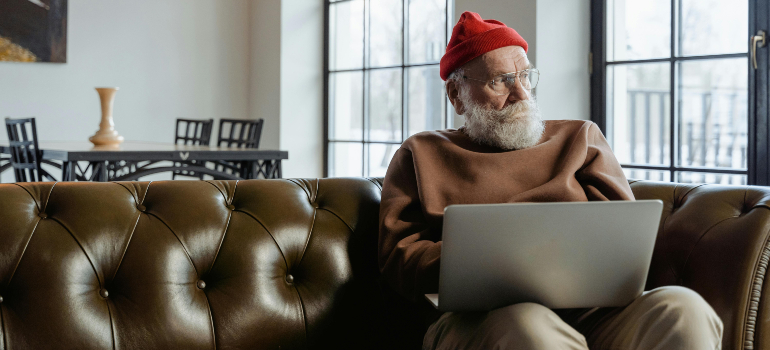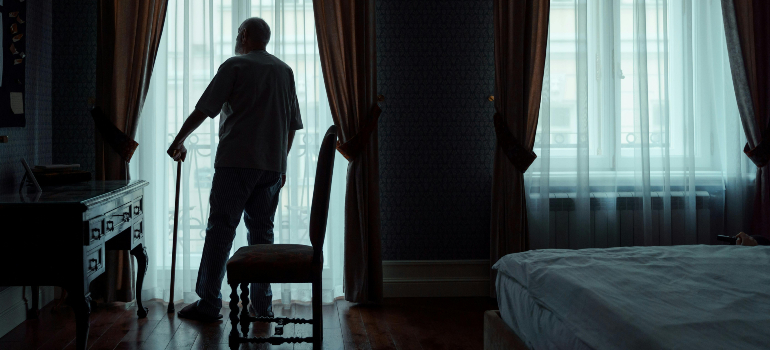Creating a Comfortable New Home: Interior Design Tips for Seniors
Get a QuoteBefore completing a move with a moving company in Maryland, one important thing to do is to ensure the new home suits the needs of seniors. Creating a space that goes beyond comfort and focuses on safety and ease of daily activities is essential. As we age, our needs evolve. A thoughtfully designed home can greatly enhance the quality of life for seniors by minimizing fall risks, facilitating movement, and ensuring help is always within reach. This guide provides essential interior design tips for seniors, helping you create a home that meets all their needs.
What Unique Considerations Should Influence Home Design for Seniors?
When designing a home for seniors, several key factors should be considered to enhance safety and comfort:
Mobility:
- Ensure that all doorways are wide enough to accommodate walkers or wheelchairs.
- Opt for smooth, non-slip flooring to prevent falls.
- Provide ample space for easy maneuvering around furniture and other obstacles.

Accessibility:
- Install ramps or stairlifts where necessary to provide access to different levels of the home.
- Lower countertops and cabinets for easy reach.
- Include grab bars in bathrooms and other potentially slippery areas.
Ease of Use:
- Use lever handles instead of knobs on doors and faucets for easier operation.
- Ensure that light switches are at a reachable height and consider motion-sensor lighting.
- Choose furniture that supports easy movement and provides stability, such as chairs with armrests.
How Do Mobility and Accessibility Play a Role in Interior Design for Seniors?
Mobility and accessibility ensure that seniors can move around their homes with ease and safety, which significantly impacts their independence and quality of life.
Mobility Considerations:
- Wide Doorways and Hallways: Doorways should be wide enough to accommodate walkers and wheelchairs, typically at least 32 inches wide. Hallways should also be spacious to allow easy navigation.
- Non-Slip Flooring: Floors should be smooth but not slippery. Consider materials like low-pile carpets, vinyl, or hardwood with a non-slip finish.
- Clear Pathways: Arrange furniture and decor to create clear, unobstructed pathways, similar to how you would provide clear pathways for your long distance movers in Maryland, on moving day. This reduces the risk of tripping and falling.
Accessibility Features:
- Ramps and Stairlifts: For multi-level homes, installing ramps or stairlifts ensures all areas of the home are accessible.
- Grab Bars and Handrails: Place grab bars in bathrooms and along stairways to provide support. Handrails should be installed on both sides of staircases.
- Lowered Fixtures: Countertops, sinks, and cabinets should be at a height that is easily reachable from a seated position.
What Types of Furniture Enhance Comfort and Safety for Seniors?
The furniture should support easy movement, stability, and ease of use. When moving to a new home, senior movers can assist by carefully carrying and placing furniture to ensure optimal safety and accessibility. Their expertise can help in arranging the space effectively to meet the unique needs of seniors. Key furniture features include:
- Chairs with Armrests: Chairs should have sturdy armrests to assist with sitting down and standing up. The seat height should be such that feet rest flat on the floor without straining.
- Firm Cushions: Sofas and chairs with firm cushions make it easier to get up from a seated position. Avoid overly soft or low seating that can be difficult to rise from.
- Adjustable Beds: Beds that can be adjusted in height help seniors get in and out of bed more easily. Consider beds with remote controls for adjusting head and foot positions.
- Stable Tables: Tables should be sturdy and stable to provide support when leaning or using them for balance. Avoid tables with wheels or unstable bases.
- Easy-Access Storage: Furniture with drawers and shelves that are easy to open and close, and within reach, helps seniors access their belongings without unnecessary strain.

Why Is Proper Lighting Crucial in Interior Design for Seniors?
Well-lit rooms reduce the risk of falls, which is especially important for older adults. Make sure to install lights at every entry point so no one has to move in the dark. In places where seniors spend a lot of time, like kitchens or reading areas, add extra, focused lights. This makes cooking and reading easier and safer. Don’t forget night lights in hallways and bathrooms. This will prevent accidents during nighttime trips.
Which Flooring Choices Help Prevent Falls and Facilitate Mobility?
Floors need to be slip-resistant to avoid accidents. At the same time, they should allow for easy movement of walkers and wheelchairs. A low pile carpet is a good option because it offers a balance—it can cushion a fall, reducing the risk of serious injury, yet it’s not so thick that it makes moving difficult. For hard flooring, options like laminate or vinyl are better than tiles or polished wood, as they’re less slippery and safer for walking. Avoid high gloss finishes as they can create a slip hazard, especially when wet.
What Modifications Make Bathrooms Safer for Seniors?
Bathrooms can be hazardous for seniors due to slippery surfaces and the need to navigate tight spaces. Making specific modifications can greatly enhance safety and reduce the risk of accidents. Here are some key changes that can make bathrooms safer for seniors:
- Install Grab Bars: Place grab bars next to the toilet and in the shower to provide support and reduce the risk of slipping.
- Walk-In Showers: Eliminate the need to step over a high tub edge by installing a walk-in shower, reducing the tripping hazard.
- Non-Slip Mats: Use non-slip mats on the floor of the shower and beside the bathtub to provide extra grip underfoot.
- Shower Seat: Include a shower seat to allow for sitting while bathing, which helps prevent fatigue and exhaustion.
- Raised Toilet Seats: Install raised toilet seats to reduce the distance one has to lower themselves, making it easier to use the bathroom independently.
How Can Kitchen Design Cater to the Needs of Seniors?
Lowering countertops allows someone in a wheelchair to cook or clean without struggle. Pull-out shelves mean less bending and reaching for items. Bright, uniform lighting prevents shadows, thus making it easier to see what you’re doing, which is crucial when handling hot dishes or sharp knives.
Appliances should have straightforward controls that are easy to navigate. Side-opening ovens at a comfortable height eliminate the need to bend down, which makes baking and roasting easier on the back. These adjustments create a kitchen where seniors can cook and enjoy meals easily.
How Should You Design a Bedroom to Maximize Comfort and Safety for Seniors?
The bedroom should be a comfortable and safe space for seniors. Ensure the path to the bed is clear of obstacles to prevent tripping. Nightstands should be within easy reach from the bed and consider placing a light switch or lamp within arm’s reach for convenience. Wardrobes with sliding doors are easier to use and reduce the need for excessive reaching or bending. Choose a bed height that allows for easy access—neither too high nor too low. Adjustable beds are an excellent option as they can be set to the perfect height and angle, promoting better sleep and reducing the effort needed to get in and out of bed.

How Can Modern Technology Enhance Living Spaces for Seniors?
Modern technology offers many benefits for seniors at home. For instance, voice-activated devices can turn lights on or off without needing to reach for a switch. They can also adjust the thermostat, so there’s no need to get out of bed. For safety, smart locks can secure doors with a simple command.
Wearable devices such as smart watches are also a great investment, as they:
- monitor heart rate with built-in health tracking features
- detect falls
- track location with GPS
- allow seniors to call for help via emergency SOS features
However, it’s crucial that these technologies are easy to use. They should have clear instructions and be reliable.
Interior Design Tips for Seniors Contribute to Creating a Comfortable Home
Following these interior design tips for seniors, you can create a space that supports them in living independently and safely. A well-designed home can prevent accidents, ease daily tasks, and ensure that seniors can enjoy their homes to the fullest. At Interstate Moving & Storage, we are committed to assisting with the move by ensuring that their belongings are safely transported to their new, fully equipped, and functional homes. Our goal is to make the transition as smooth as possible, so they can settle into a space that meets all their needs.
